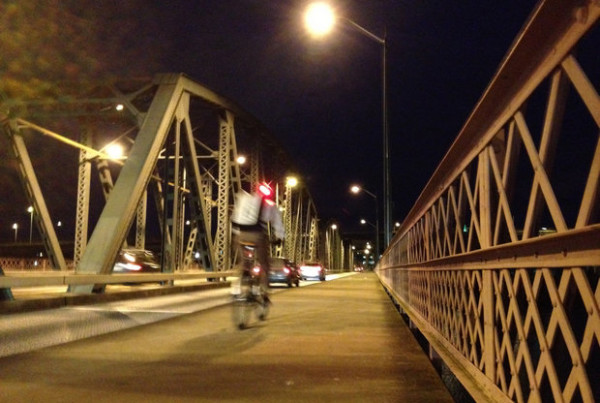The Boston Globe: With crash data, Boston tries to make bicycling safer
Ridership up; 50% drop in injury rate is the goal
By Martine Powers
| Globe Staff
May 15, 2013
City transportation officials hope to introduce cycle tracks, bike lanes separated from the street by a barrier, on a few sections of busy roads.
Bike crashes in Boston are most likely to occur on Massachusetts Avenue, between 4 and 7 p.m., to men between 19 and 31 years old. And they most often occur when a driver fails to see a cyclists or opens a door on a bike.
Those insights are contained in a report of unprecedented scale that compiles years of data on bike collisions in the city. With a slew of statistics on crash locations and times, helmet use, and bicyclist and motorist behavior, the report, set to be released Wednesday, could prompt changes in how city officials strategize to ensure the safety of cyclists.
Mayor Thomas M. Menino, whose office commissioned the study, plans to announce a pledge to cut the cyclist crash injury rate by 50 percent by 2020, a goal, he said, that will be made possible by the findings of the report.
“This document will help us smartly apply our resources to continue improving our streets,” Menino said in a statement.
Along with extensive data — gathered from crash reports and statistics from Boston Police, Boston Emergency Medical Services, and Boston Bikes, the mayor’s probiking initiative — the report also outlined recommendations to improve cyclists’ safety.
City transportation officials hope to introduce cycle tracks, bike lanes separated from the street by a barrier, on a few sections of busy roads.
Police, who have for years issued warnings to cyclists who run red lights or glide through stop signs, will now hand out $20 citations.
And city officials are considering a plan to push city councilors to pass a law requiring all cyclists to wear a helmet.
“We’d like to solve that through education, as opposed to legislation,” said Thomas Tinlin, commissioner of the Boston Transportation Department. “But we’ll see how far we get with that.”
But some question whether city officials have used the report to jump to the wrong conclusions, directing more attention on the behavior of cyclists who run red lights or do not wear helmets rather than on improving the city’s infrastructure.
According to the statistics released by the mayor’s office, the Boston Police Department recorded a total of 1,446 incidents and nine fatalities between 2010 and 2012. Boston EMS recorded 1,432 incidents and eight fatalities — a disparity from police data, the report’s authors said, because one person died after arriving at the hospital.
Over the same period, in which the rate of crashes remained relatively flat, ridership is estimated to have increased by 28 percent.
Nicole Freedman, director of Boston Bikes, stopped short of saying that the city’s streets are becoming safer for cyclists; there are not enough years of data for the trend to be statistically significant.
But, she said, if ridership continues to increase more dramatically than the number of crashes, it is a good sign.
“We know in New York, we know in other cities . . . as the ridership goes up, the number of crashes tends to stay flat, and the crash rate falls,” Freedman said. “This could be indicative of a similar trend.”
For years, city officials and transportation specialists bemoaned the dearth of comprehensive bike statistics in the city. Data were piecemeal; only some reports from police and emergency services listed information about helmets or the circumstances that led up to the collision.
The lack of hard numbers prevented city officials from getting a handle on how and where to improve Boston’s bike infrastructure.
Some of the findings of the new study are hardly surprising: Between 2010 and 2012, the Boston intersection that saw the most bike crashes is where Beacon Street meets Massachusetts Avenue, with 14 crashes, followed by the intersection of Massachusetts Avenue and Commonwealth Avenue, where 12 crashes occurred.
Crashes occur most often in the warm-weather months and at dusk, between the hours of 4 and 7 p.m.
Among cyclists who were injured and who required medical assistance, about half were not wearing a helmet, almost twice the percentage of total riders who do not wear helmets.
The report also outlined the behaviors that led to accidents, though not all police reports listed reasons.
Of the 891 crashes in which causes were listed, cyclists ran a red light or rode through a stop sign before colliding with a car 12 percent of the time. Twenty-two percent of the collisions between cars and cyclists occurred when a vehicle door opened unexpectedly on a cyclist. Eighteen percent occurred when a motorist did not see a cyclist. And twelve percent occurred when a cyclist rode into oncoming traffic.
Data on driving and biking behaviors, officials said, could have meaningful effects. They’ve begun to target taxis — responsible for a disproportionate share of doorings — to post signs encouraging passengers to look for oncoming bikes.
And because trucks have large blind spots and often do not see cyclists on their sides, the city is installing side guards on 19 public works trucks, metal barriers that prevent a cyclist from sliding underneath a truck during a collision. Officials hope owners of private trucks will be encouraged to do the same.
Boston police Captain John Danilecki, formerly of the department’s tactical bicycle unit, said the data from the report have prompted police to become more aggressive with cracking down on cyclists running red lights. Officers will begin ticketing cyclists with $20 citations, an effort that has support from the mayor’s office.
“I think a $20 fine is a small price to pay to save a life,” Freedman said.
Steven E. Miller, a founding board member of the Livable Streets Alliance and executive director of Harvard’s New England Healthy Weight Initiative, reviewed the report in advance of publication. The data, he said, were impressive in scope, and much needed — but he doesn’t agree with all of the city’s conclusions.
Instead of pushing helmets, he said, the sharp uptick of crashes that occur at sunset suggest the city should distribute bike lights. And instead of cracking down on cyclists who run red lights, he said the data suggest a need for separated bike lanes.
“Infrastructure should be a higher priority,” Miller said.
The report also highlighted the need for better and more refined crash reporting practices. By the end of this year, said Danilecki, Boston police will probably introduce new software that will allow for more detailed reporting, creating visual graphics to illustrate exactly how a crash occurred.
“Now, we’ve come up with a way to share all this data much more easily,” Danilecki said. “It’s going to have a positive impact.”

